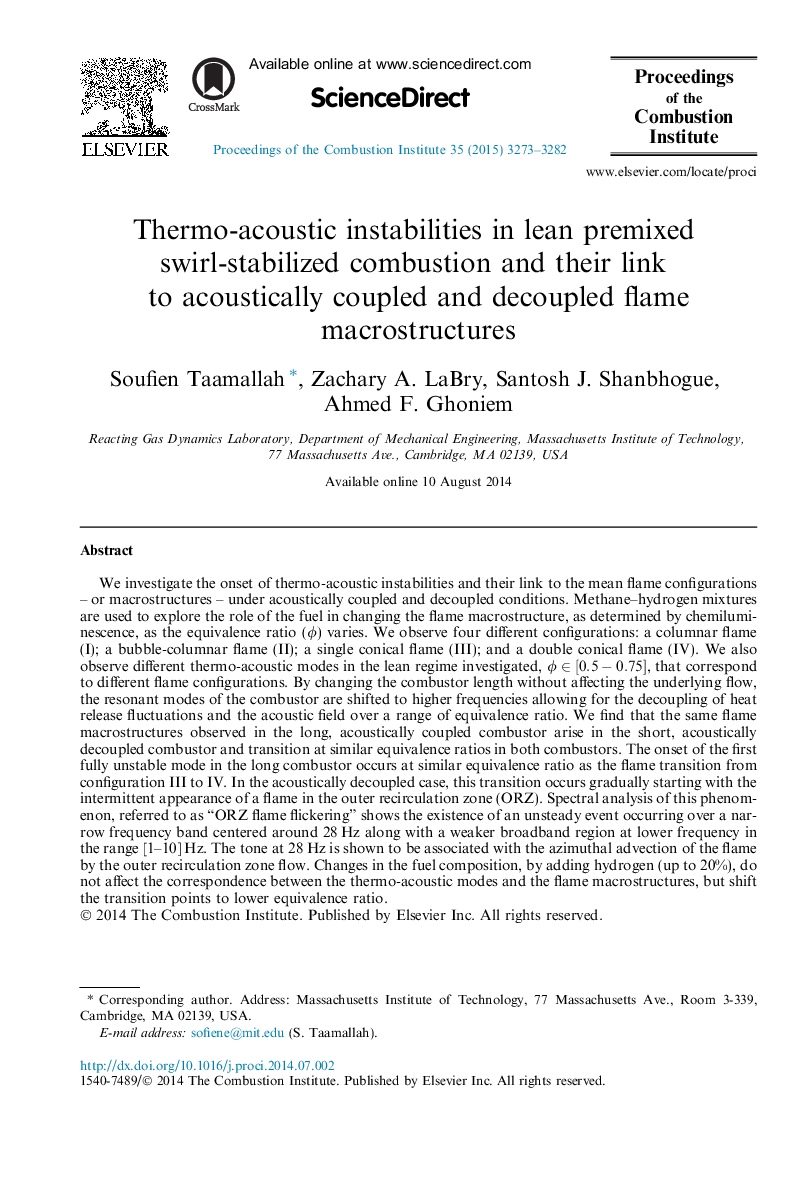| کد مقاله | کد نشریه | سال انتشار | مقاله انگلیسی | نسخه تمام متن |
|---|---|---|---|---|
| 4915584 | 1427919 | 2015 | 10 صفحه PDF | دانلود رایگان |
عنوان انگلیسی مقاله ISI
Thermo-acoustic instabilities in lean premixed swirl-stabilized combustion and their link to acoustically coupled and decoupled flame macrostructures
ترجمه فارسی عنوان
ناپایداریهای حرارتی در لامپ های احتراق ثبات تشدید شده پیشروی شده و پیوند آنها با ساختارهای ماکرومغناطیسی شعله های آکوستیکی مرتبط و جدا شده
دانلود مقاله + سفارش ترجمه
دانلود مقاله ISI انگلیسی
رایگان برای ایرانیان
کلمات کلیدی
موضوعات مرتبط
مهندسی و علوم پایه
مهندسی شیمی
مهندسی شیمی (عمومی)
چکیده انگلیسی
We investigate the onset of thermo-acoustic instabilities and their link to the mean flame configurations - or macrostructures - under acoustically coupled and decoupled conditions. Methane-hydrogen mixtures are used to explore the role of the fuel in changing the flame macrostructure, as determined by chemiluminescence, as the equivalence ratio (Ï) varies. We observe four different configurations: a columnar flame (I); a bubble-columnar flame (II); a single conical flame (III); and a double conical flame (IV). We also observe different thermo-acoustic modes in the lean regime investigated, Ïâ[0.5-0.75], that correspond to different flame configurations. By changing the combustor length without affecting the underlying flow, the resonant modes of the combustor are shifted to higher frequencies allowing for the decoupling of heat release fluctuations and the acoustic field over a range of equivalence ratio. We find that the same flame macrostructures observed in the long, acoustically coupled combustor arise in the short, acoustically decoupled combustor and transition at similar equivalence ratios in both combustors. The onset of the first fully unstable mode in the long combustor occurs at similar equivalence ratio as the flame transition from configuration III to IV. In the acoustically decoupled case, this transition occurs gradually starting with the intermittent appearance of a flame in the outer recirculation zone (ORZ). Spectral analysis of this phenomenon, referred to as “ORZ flame flickering” shows the existence of an unsteady event occurring over a narrow frequency band centered around 28 Hz along with a weaker broadband region at lower frequency in the range [1-10] Hz. The tone at 28 Hz is shown to be associated with the azimuthal advection of the flame by the outer recirculation zone flow. Changes in the fuel composition, by adding hydrogen (up to 20%), do not affect the correspondence between the thermo-acoustic modes and the flame macrostructures, but shift the transition points to lower equivalence ratio.
ناشر
Database: Elsevier - ScienceDirect (ساینس دایرکت)
Journal: Proceedings of the Combustion Institute - Volume 35, Issue 3, 2015, Pages 3273-3282
Journal: Proceedings of the Combustion Institute - Volume 35, Issue 3, 2015, Pages 3273-3282
نویسندگان
Soufien Taamallah, Zachary A. LaBry, Santosh J. Shanbhogue, Ahmed F. Ghoniem,
